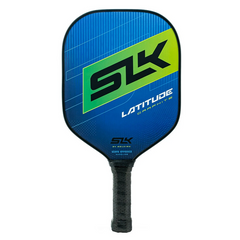
The Ultimate Guide to Choosing a Pickleball Paddle
The Ultimate Guide to Choosing a Pickleball Paddle
>>Check out our catalog of pickleball paddles here!<<
With pickleball becoming increasingly popular over the past few years, I'm sure it will have attracted a lot of new players into the sport. For those of you who are new and need help choosing a paddle, look no further. This guide will break down the different factors you should consider when choosing a pickleball paddle and help narrow down your choices.
To start off, here is the basic anatomy of a pickleball paddle:

1. Paddle Weight (oz)
The first factor you should consider is the overall weight of the paddle.
Light weight = 7.3 or less
Mid-weight = 7.3-8.2
Heavy weight = 8.2 or more
The heavier the paddle, the more power you can get out of your shots. This is good for players who are looking for an all-out attacking play style. The downside is lower maneuverability of the paddle, making it harder for fast exchanges. Your arm will fatigue at a faster rate due to the heavier weight, and therefore it is not recommended to use a heavy weight paddle if you have pre-existing arm injuries.
The lighter paddles will have less power, but you will have increased control as you will be able to use more wrist action which lets you add spin to your shots. Light weight paddles are good for players who like to dominate at the front court.
2. Material
The factor that has the most influence on the price of the paddle will be the type of material used for the paddle face.
There are generally four different types of materials used for the paddle face:
Wood
Check out this 2 player wooden paddle set by Franklin
Fiberglass (Composite)
Fiberglass (a.k.a. composite) is a common material that is used for the paddle surface. It is not as stiff/rigid as the other materials and creates a "trampoline" effect when the ball comes into contact with the surface, generating ample power in your shots.
Check out this Fiberglass Paddle by Babolat
Carbon Fiber
Carbon fiber surfaces are stiffer compared to fiberglass. It gives you better feel/control in your shots but generates less power.
Check out this carbon fiber paddle by CRBN2
Graphite
Graphite surfaces have better feel than fiberglass and generates similar power compared to carbon fiber, sort of a middle ground between the three. It is often hard to distinguish between graphite and carbon fiber.
Check out this graphite paddle from Selkirk
Honeycomb Core
Aside from the surface material, there is also the honeycomb core underneath that makes up the bulk of the paddle. Most paddles on the market use some variation of a polymer core which is essentially just a really hard plastic. The only thing you need to take note of is the core thickness.
A core thickness of 16mm+ is good for beginners as the softer feeling increases control of the ball and improves stability of the paddle from miss-hits.
As you decrease in thickness (14mm, 10mm etc..) you will increase power and decrease control/feel.
3. Head Shape
Official rules state that the length of the paddle cannot exceed 17 inches. In addition, the combined length and width of the paddle cannot exceed 24 inches (including edge guard and butt cap). The head shape of the paddle can be distinguished into 3 different types whilst fulfilling these conditions.
Classic
The original paddle shape with a length of about 16 inch and width of 8 inch. Provides a balance of power, spin, and maneuverability.

Check out the classic head shaped paddle by Franklin
Wide
Measures a wider face of about 8.5 inches and a shorter length of 15.5 inches. This shape has an enlarged sweet spot and high maneuverability.

Check out the wide head shaped paddle by Selkirk
Elongated
This shape has a length of around 16.5 inches and width of 7.5 inches. Provides more power, reach, and spin but sacrifices maneuverability and has a smaller sweet spot.

Check out the elongated head shaped paddle by CRBN2
4. Grip Size and Handle Length
The length of a paddle can vary from 4.5-6 inches. In general the longer handle length is recommended for players who like to use two-handed backhands like that in tennis. The longer handle can also help with generating more power and spin in your shots as it provides more leverage in your swings. Shorter handles on the other hand are easier to use and have greater maneuverability.
Pickleball paddle grip sizes are similar to those in tennis where it increases in increments of 1/8 inch.
| US Size | Size in mm |
| 4 inch | 100-103mm |
| 4 1/8 inch | 103-106mm |
| 4 1/4 inch | 106-110mm |
| 4 3/8 inch | 110-113mm |
| 4 1/2 inch | 113-118mm |
| 4 5/8 inch | 118-120mm |
When in doubt, you should use a smaller grip size as you can always add on an overgrip to make it bigger.
If you don't know your grip size, you can use this simple rule as a guideline.
| Height | Grip Size |
| Under 5'2" | 4 inch |
| 5'3" to 5'8" | 4 1/4 inch |
| 5'9" + | 4 1/2 inch |
If you want a short summary, check out our athletes explanation on YumoTube!
Now that you've read to the end of the guide, you should be ready to choose a paddle thats suitable for you.



